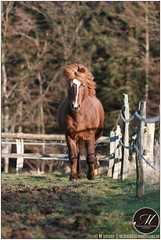This horse has straighter legs (versus the crooked legs shown in a previous blog), the laterals travelling on separate tracks and the flight of the legs is straight versus the curved flight path of crooked limbs.
Click onto the image to see a larger version.
Teaching a Horse to Talk
-
Listen very carefully to hear the horses "talking". As they learn, they
will get louder; this is just the start.
14 years ago
















































